
Something of a desultory miscellany. Some secrets, some scandals, some events, some curiosities, some achievements; some interesting, some tragic, some romantic, some funny...as it says on the label - a potpourri. Wrights, Picketts, Berrys, Conibeers, Hectors, Feys, Luxtons, Willings, Pitts, Mordeys, Pollards, Heards, Slees
and more...
The Rector, his Wife and the Curate
 In May 1914, scandal overtook the Reverend Theophilus Rodick Willing at Blackpool Magistrate’s Court, in messy and public revelations of a family dispute. The Court heard accusations of drunkenness and abuse, unfaithfulness, seduction and betrayal, secret correspondence, forged confessions, and shocking suggestions concerning blackmail and a brothel. The scandal involved Theo, his young wife, his best friend the curate of South Shore Parish Church, Blackpool and the Freemasons, all stoked-up by scheming and outraged in-laws. Little could Theo have guessed when he married his 19-year old bride in Blackpool, that in less than a year, events would land him in the town’s Magistrate's Court accused of desertion, and facing an order for maintenance. Annie Willing, née Stafford, the daughter of Henry Stafford, painter and decorator, charged that life with Theo was one of torture, forcing her out of the marriage home, his behaviour such that she could not bear to live with him, and thus this state of affairs amounted to his desertion of her. Theo insisted that not only had he not deserted her, but that he fervently wished her to return to their home in North Hill, Cornwall, where he was Rector of the Parish. Her lawyers claimed his pleas were bogus. The court sat from 10.45am to 7.45pm hearing the "Amazing Allegations" as the local paper described them. Lawyers for the two sides clashed fiercely throughout the day.
In May 1914, scandal overtook the Reverend Theophilus Rodick Willing at Blackpool Magistrate’s Court, in messy and public revelations of a family dispute. The Court heard accusations of drunkenness and abuse, unfaithfulness, seduction and betrayal, secret correspondence, forged confessions, and shocking suggestions concerning blackmail and a brothel. The scandal involved Theo, his young wife, his best friend the curate of South Shore Parish Church, Blackpool and the Freemasons, all stoked-up by scheming and outraged in-laws. Little could Theo have guessed when he married his 19-year old bride in Blackpool, that in less than a year, events would land him in the town’s Magistrate's Court accused of desertion, and facing an order for maintenance. Annie Willing, née Stafford, the daughter of Henry Stafford, painter and decorator, charged that life with Theo was one of torture, forcing her out of the marriage home, his behaviour such that she could not bear to live with him, and thus this state of affairs amounted to his desertion of her. Theo insisted that not only had he not deserted her, but that he fervently wished her to return to their home in North Hill, Cornwall, where he was Rector of the Parish. Her lawyers claimed his pleas were bogus. The court sat from 10.45am to 7.45pm hearing the "Amazing Allegations" as the local paper described them. Lawyers for the two sides clashed fiercely throughout the day.
Rev. Theophilus Willing
Annie outlined her allegations first - her evidence implied that Theo was cruel and brutish. She alleged that within weeks of the marriage she found that he drank to excess. She claimed he tried to force her against her will to drink whisky, and smoke cigarettes. He gave her no housekeeping, verbally abused her and threatened to thrash her. He would not give her the money to visit her parents in Blackpool. She made the trip, only after being sent the money by her father, and she returned to Cornwall with a friend, Miss Devon. One night, alarmed at his drunken attitude, when he threatened again to thrash her, she spent the night in her friend's bed. She claimed that Theo took his tools and tried to break into their room. They pushed chairs against  the door. Weeks later, when another friend was staying, Theo insisted that Annie and her friend should stay in a Temperance Hotel in Plymouth, where he would join them - this was engineered so that she should not see her father who had announced he was coming to North Hill. The first evening there, hearing voices in the corridor, she opened the door to find her husband talking to a young woman, only half-dressed in her camisole, smoking a cigarette. Subsequently Annie learned from the woman that "she was there for the purpose of receiving sailors". Shocked, Annie demanded that the party move to another hotel. Shortly after this incident, only seven months after the wedding, the marriage deteriorated beyond salvation. Theo unaccountably rushed off to her home town of Blackpool, sending Annie to stay in Brighton. She alleged she was left there for two weeks, friendless and penniless. She wrote to her husband and to her father. Theo returned to Brighton unannounced to meet her - his manner was cold and hostile. He told her that he had heard something about her in Blackpool, "that he had wished he had never seen her, and that she should leave him". He told her to go to the devil and treated her, she claimed, "like a pig", refusing to stay the night with her in the hotel. Her father arrived in Brighton later that day, and after a confrontation with Theo at the station the next day, he took his daughter with him back to Blackpool. And thus their brief marriage seemed to have ended.
the door. Weeks later, when another friend was staying, Theo insisted that Annie and her friend should stay in a Temperance Hotel in Plymouth, where he would join them - this was engineered so that she should not see her father who had announced he was coming to North Hill. The first evening there, hearing voices in the corridor, she opened the door to find her husband talking to a young woman, only half-dressed in her camisole, smoking a cigarette. Subsequently Annie learned from the woman that "she was there for the purpose of receiving sailors". Shocked, Annie demanded that the party move to another hotel. Shortly after this incident, only seven months after the wedding, the marriage deteriorated beyond salvation. Theo unaccountably rushed off to her home town of Blackpool, sending Annie to stay in Brighton. She alleged she was left there for two weeks, friendless and penniless. She wrote to her husband and to her father. Theo returned to Brighton unannounced to meet her - his manner was cold and hostile. He told her that he had heard something about her in Blackpool, "that he had wished he had never seen her, and that she should leave him". He told her to go to the devil and treated her, she claimed, "like a pig", refusing to stay the night with her in the hotel. Her father arrived in Brighton later that day, and after a confrontation with Theo at the station the next day, he took his daughter with him back to Blackpool. And thus their brief marriage seemed to have ended.
Annie Hunter Stafford
On the face of it, Annie's story sounds compelling, and sadly not so unusual, at a time when women were still very much regarded as part of the man's chattels in a marriage, her story differing only from numerous other sad tales in that her husband was a mild looking young clergyman. But Annie's demeanour during cross examination was at times uncooperative, and her answers sometimes glib, evasive or contradictory. Her husband's lawyer began to tease out an altogether different dimension to the story, despite attempts by Annie's lawyer to prevent him.The Reverend Fearnley Youens  was curate at the South Shore Parish Church where Annie taught Sunday School and was an active church member. Youens had been Theo's best friend at University, and he had introduced Theo to Annie. What began to emerge in court was the allegation that Annie had been closer to Fearnley Youens than was seemly. During their engagement Theo had discovered a letter written by Annie to a gentleman, signed "your loving Phyllis". The court heard that shortly before the wedding whilst Theo was in Jersey on business, something had happened between Annie and Youens. Annie's solicitor intervened to prevent further discussion of what may have occurred. Then followed an accusation that Annie's mother had demanded a £100 of the Rev. Youens shortly after the wedding. The demand was apparently linked to a confession Annie had written for her mother, a shocking confession describing what had occurred between her and Youens - a confession that Annie subsequently withdrew in letters written to Youens. This confession and the impropriety it alleged, committed by Youens, with Annie's apparent acquiescence, was at the heart of the scandal. Her father admitted that he had written secret letters to his daughter at North Hill, and sent her money so that she could come to Blackpool and verify her confession in person to the Freemasons, against Youens. When cross-questioned, other Stafford family members acknowledged a conspiracy of spite against Youens. Theo's solicitor seems to have come closest to the mark when he declared, "Three weeks after the wedding an allegation was made by the girl's mother to Mr Youens implicating him and the girl, and demanding money. The matter was taken up by Mr. Stafford who tried to get evidence to bring before the Freemasons so as to have a hold over Mr Youens. When the confession arrived, Stafford started to make use of it. The matter came before the Masons but nothing happened and the thing subsided. The girl went back and lived with her husband until an announcement was made in the papers that Mr Youens was to be married, when the matter was revived to punish Mr Youens out of spite." It was when he heard of this alleged impropriety between his wife and his best friend, that Theo had rushed to Blackpool to try to get at the truth, sending Annie to Brighton, away from the row. Then on hearing the allegations in full, Theo had returned to Annie in Brighton to confront her. But her father had arrived later to take her back to Blackpool to stir things up again.
was curate at the South Shore Parish Church where Annie taught Sunday School and was an active church member. Youens had been Theo's best friend at University, and he had introduced Theo to Annie. What began to emerge in court was the allegation that Annie had been closer to Fearnley Youens than was seemly. During their engagement Theo had discovered a letter written by Annie to a gentleman, signed "your loving Phyllis". The court heard that shortly before the wedding whilst Theo was in Jersey on business, something had happened between Annie and Youens. Annie's solicitor intervened to prevent further discussion of what may have occurred. Then followed an accusation that Annie's mother had demanded a £100 of the Rev. Youens shortly after the wedding. The demand was apparently linked to a confession Annie had written for her mother, a shocking confession describing what had occurred between her and Youens - a confession that Annie subsequently withdrew in letters written to Youens. This confession and the impropriety it alleged, committed by Youens, with Annie's apparent acquiescence, was at the heart of the scandal. Her father admitted that he had written secret letters to his daughter at North Hill, and sent her money so that she could come to Blackpool and verify her confession in person to the Freemasons, against Youens. When cross-questioned, other Stafford family members acknowledged a conspiracy of spite against Youens. Theo's solicitor seems to have come closest to the mark when he declared, "Three weeks after the wedding an allegation was made by the girl's mother to Mr Youens implicating him and the girl, and demanding money. The matter was taken up by Mr. Stafford who tried to get evidence to bring before the Freemasons so as to have a hold over Mr Youens. When the confession arrived, Stafford started to make use of it. The matter came before the Masons but nothing happened and the thing subsided. The girl went back and lived with her husband until an announcement was made in the papers that Mr Youens was to be married, when the matter was revived to punish Mr Youens out of spite." It was when he heard of this alleged impropriety between his wife and his best friend, that Theo had rushed to Blackpool to try to get at the truth, sending Annie to Brighton, away from the row. Then on hearing the allegations in full, Theo had returned to Annie in Brighton to confront her. But her father had arrived later to take her back to Blackpool to stir things up again.
It seems that in time, Theo soon either came to disbelieve that anything had happened, or forgave his wife and his friend.
But what of Annie's allegations against her husband? It was established that there was no suggestion of impropriety in the incident with the half-dressed woman in Plymouth.

North Hill Rectory, Cornwall
Rather strangely, Annie seems to have insisted on being called Miss Willing when she was away from North Hill, and would pass herself off as Theo's sister. The Court learned from the letters she wrote during her two weeks in Brighton that, far from being abandoned, friendless and penniless, she had struck up a friendship with a clergyman and his family in her hotel, who knew Theo, and she went to the theatre with them. Pretending to be single, she seems to have become over-friendly with the son of the family, who subsequently wrote to her.
We can conjecture perhaps that Annie, very young and immature, and used to a busy social life in Blackpool, where she was a successful and celebrated singer, found herself married to an older man, confined in a remote rural parish, in a large and gloomy Rectory. Had she discovered too late the reality of her married life? Pretending to be single probably reflected her wishful thinking. She perhaps saw an end of the marriage as the only way to recapture the life she had led, and although she obviously had some affection for Theo, she was content to be drawn into her parents' malicious conspiracy as a way out of the marriage.
However culpable were Annie and her parents in all this, it is difficult to accept that the smoke was without fire; it seems likely that there was something in the behaviour of both Theo and Youens that was inappropriate.
Nonetheless, after their marathon sitting, the Bench was unconvinced by Annie's story, and they announced that they would not make any order for maintenance. At this, Theo's solicitor told the court that his client was still anxious for his wife to return to him, but if she still refused, then Theo would not see her penniless, and would make her an allowance for her maintenance.
Annie was not to return to the marriage. Their separation became permanent and legal, when in February 1916 Theo was granted a decree nisi on the grounds of Annie's misconduct with a co-respondent named James Forrester. In 1922 Theo married again and went on to have three children. His second marriage after the dissolution of his first marriage was regarded by the Church of England as even more scandalous than the court case of 1914. Nonetheless he remained as incumbent of North Hill until 2 years before his death in 1967, the living being his. Annie was to have a daughter in July 1915, having been living with Forrester since October 1914. She married Forrester in the summer of 1916, the couple had another daughter and the family migrated to the US in 1919. They settled in the Bronx at first and then New Jersey. After James's death Annie moved back to the UK. In 1939 she was living with her daughter and son-in-law at 52 Lache Park Avenue, Chester. She died in Birmingham in 1972.

Blackpool about 1914
With gratitude to Philip Haynes and Adrian Radcliffe for their help with the research
The Rare Divorce of Sarah Ann Pickett
 Maidstone
MaidstoneThe Picketts of Sandford were for generations shopkeepers and tailors. It was probably this trade connection that took Harry Pickett to Maidstone, Kent, where he worked as Shopman for Woollen Draper Joseph Butcher, living with the Butchers at their Week Street home in the centre of the town. Less than 700 metres away Widow Eliza Gasson was licensee at the Kingsley Arms, Melville Road, Maidstone. Harry's local pub? In any event he met Eliza's only daughter Sarah Ann, and in July 1872, 23 year-old Harry married the 20 year-old at St Martin-in-the-Fields in Trafalgar Square. The marriage was doomed. Three children were born to the couple, and all three died within 5 years. According to Sarah, about two years into the marriage Harry began a systematic course of cruelty against his young wife, striking and beating her. They moved from Maidstone to South London, living in Camberwell and Brixton. The cruelty seems to have intensified. "Whilst there my husband constantly beat me, and I was afraid he would kill me... he reduced me to a state of starvation and day after day left me without any food in the house. " Harry was seeing other women. In 1876 he contracted VD, but Sarah Ann did not find out until August 1877. This was the final straw, and at last she moved out. After her departure Harry entertained himself with Maidstone prostitutes, but Sarah seems to have retained that hope that he would reform, and that perhaps their marriage could be salvaged. Then in early 1879 Harry sailed for Australia. In July 1879 Sarah filed a petition for divorce. Her sworn statement was supported by a witness, and the divorce was granted on 30th April 1880 and became absolute in November of that year. Sarah returned to Maidstone to live with her mother, who had by then remarried. On 21st June 1881 Sarah married builder William King of Old Brompton. Sarah bore sons George and Simmonds and daughter Mary to her second husband. Happily by 1901 she seemed to be enjoying a comfortable marriage to a successful tradesman. She died in 1911 aged 58.
Harry had gone to Sydney, Australia, where initially, at least, he worked as a warehouseman. He settled down, married Surrey emigrant Jemima Lancashire in July 1882, and together they had 4 children who went on to establish a Pickett clan in New South Wales.
In the latter half of the 19th century there were only about 200 divorces per year, and very few of these granted to women. Harry sacrificed his opportunity to give his side of the story. Had he done so there is some doubt that Sarah would have been granted a divorce, as the law was so stacked against women. Indeed it may only have been the fact that Harry had emigrated that convinced her to attempt the divorce. That she did, and that she was successful, was rare indeed for the times.
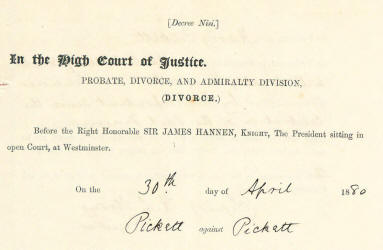
Greatly Neglected
Sarah Ann Heard was born in 1861 at New Buildings, Sandford, to Daniel Heard, farm labourer, and his first wife Elizbeth Chudleigh. Her mother died when she was 7, she had a new stepmother by the time she was 8 and soon there were stepbrothers in the household. It is not clear if Sarah attended a primary school before the age of 11, but there was ample provision for primary education in Sandford for those whose family circumstances allowed them to take advantage of it. She was described as a scholar in the 1871 census, but that tended to be the default description for children over 4 and meant little. Only when she was 14 did she start attending Haywards School, Crediton, on 23 May 1876. She joined in the 5th Class, when routine admissions were to the 3rd class, at age 11. She had barely moved up into the 2nd class when she was withdrawn from school, in October 1876, after just 5 month's education as she was "wanted at home". That was not so uncommon for children in poor families. But more unusual was the stark comment that a teacher wrote in the register when noting her withdrawal. " A greatly neglected girl".
We can surmise that this was referring to more than her abbreviated education of barely 5 months' duration. The neglect of the youngest child of a dead wife in a household where the new wife had her own children is not only the stuff of fiction, but was then a common reality, and we can speculate that was the nature of Sarah Ann's neglect.
Despite her upbringing Sarah Ann managed to make the most of her life. She went into domestic service. By 1881 she was working for surgeon
Richard Andrews and his wife in Cowick Street, Exeter, as their general domestic servant. She obviously did well in service, for ten years later she was working for the chairman of the Fry's Chocolate business, Francis James Fry, in his Long Ashton home. Sarah Ann was cook, in a household staffed by a governess, a nurse, a parlour maid, a kitchen maid and a housemaid. As well as being Chairman of the chocolate manufacturers Francis Fry was a JP, was made Sheriff of Bristol, and was married twice, with fours sons and two daughters. This must have been a very responsible job for Sarah Ann to hold.
 Francis Fry
Francis Fry
In 1892 Sarah Ann married domestic gardener Thomas Milford, and would probably have left domestic service then. They married in Clifton parish church, Bristol, and Sarah Ann's sister Maria was a witness. Husband Thomas and his family were from Crediton, but he had moved to the Bristol area in about 1875, at first living with his brother and his family, and later with his widowed father who had joined him, in Clifton. He and Sarah Ann continued to live in Clifton. By 1911 they had a boarder living with them. The evidence suggests that Sarah and Thomas had a settled domestic life. They had no children. Thomas died in 1931 in Clifton, and Sarah died two years later.

Letters of Lewis Wright and Mary Martha Berry

Lewis Wright and Mary Martha Berry

"Sandford, Dec 1st 1872.
My Dear Mary, I have not heard whether you arrived home safe or not as when I was at Crediton they have not heard but I hope you are. I am happy to say that I feel in much more comfortable state of mind than I did when I wrote to you last for believe me I shall never forget that Sunday evening when you spoke that dear little word 'yes' for I am sure if I loved you before that, I know it is a great deal more now and more especially now that I know that you love me in return....There is a Grand Yeomanry Ball to be held at Crediton on Decr 12th for Mr Bullers troop in full dress uniforms.... The best of it is Jim [his brother] can't dance, so me, Jim, Mr Snow and Mr Butt have spoken to Mr Harvey to give us a few lessons. I thought I might as well learn too. So we commence on Tuesday for five nights, two hours of a night. ...Just fancy me going dancing. I expect it will be very funny at first but I shall soon learn....With love that will last for you as long as I live and believe me to remain yours affectionately,
Lewis.
(I never pass that road without thinking of that little word 'yes')"
"Sandford, August 13th 1873.
My dearest Marie, I was very much pleased to receive your letter yesterday morning and to see that you were arrived safe.....There was an accident happened to the N Devon train on Monday afternoon, the engine got into the water at Cowley Bridge. Mother was in Exeter on Monday but fortunately came home by the train before. They have not got the Engine out yet...I have not been in to Crediton since and I don't think I shall until Sunday evening. I shall miss your dear company on Saturday night, the company that I value more than any one else in the world, for without your love Marie I should be miserable. (May I expect another letter if you have time) I must conclude as I am very busy. Accept my love and believe me to remain your ever affectionate, Lewis
May Heaven protect me for your sake
Pray both night and day
That I some day may call you mine
My own dear MMB
For you are all the world to me
Although so far away
I often think of the pleasant walks
And little MMB"
The course of their love most certainly did not run smooth. It is evident that Mary's stepmother Emma Holcombe, now married to her second husband, did not approvc of Lewis as a future son-in-law.
"Sandford, March 30th 1873.
My dearest Marie,.....I should think your Mother has forgotten me altogether or at least for some little time. I expect when she gets in a temper with you, you will know what to say to her and I have no doubt she will believe you. You have promised me whatever your Mother says to you that you will not alter your mind and I don't believe you will for I can assure you I will never alter mine. I love you now more than I ever did before and I am certain I shall continue to love you more and more as long as I live......I am certain it will be one of the Proudest days of my life when I call you Dear Little Wife with or without your Mothers consent.....Accept the love of one that loves you truly and sincerely and believe me remains your affectionate
Lewis."
and again...
" Sandford, June 29th 1873.
My dearest Marie.... I think it is very silly of them to keep bringing up my name before your mother. ( I don't mind how often to you) for they can see for certain how she takes it. I am going to Crediton tonight and if I see Eliza I shall talk with her about it and ask her to be kind enough not to bring up my name at all. You say you are quite at liberty to please your own self, and I believe you will but still I think it best for you to be Happy and Comfortable with your mother as long as you possibly can for my dear I have every respect for your mother because she is your mother although I firmly believe she will never like me but I don't mind that. I feel assured I have your love and believe me you shall have mine for ever. ... My dear I must conclude this, accept my love and believe me I remain your affectionate Lewis."
"Union Terrace, Crediton Dec 17 1875
My dear Lewis, I am very glad that you arrived quite safe and that you had it so nice going up. I thought you would be almost frozen, it was such a cold day, the coldest we have had. We had such a quantity of snow in the afternoon. I was obliged to go out in am. Whilst coming home I thought I would walk fast. The consequence was I almost fell and to save myself I leaned against an old woman's umbrella almost throwing her down. She looked very indignant while I only laughed....I can just fancy how much you enjoyed yourself last night at the Alhambra, And I suppose the final entry in today's programme will be Drury Lane Theatre or some other nice one. Tomorrow Thursday I wonder where you will be going. I shall be almost if not quite on the bars of the grate dreaming over the pages of the Family Herald. I think you told me you would not go the Crystal Palace as you had been there. I am sure you will have a lot to tell me when you return....I shall conclude wishing that you may enjoy yourself very much, and now accept the love of yours affectionately, Marie"
"London Inn, Dawlish, August 2 1877.
My dear Mother, I am pleased to say that Mary and myself are quite well and happy. We are enjoying ourselves very much and very quietly. We have been out all day, on the beach etc. We have just had some tea and are going out again. We want to get as much sea air as we can. We both hope you are quite well and trust you have got over the excitement of yesterday as I am sure it was a trying day for you. There is one thing I promise you faithfully that is I will always be kind to Mary. I hope you will try and believe me in this little matter. Thanking you for all past kindness and mostly for the gift of your daughter. Mary joins with me in kind. Love and believe me yours affectionately Lewis W Wright."

Bill for the delivery and medical care
of Mary Martha Wright's first baby
Lewis was true to his word, and he and Mary had a long and happy marriage. They had six children who survived to maturity. They celebrated their 50th wedding anniversary in 1927. Lewis died less than a year later, and Mary Martha, who was held in great awe by her grandchildren, survived until 1939.
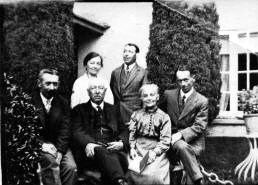
Mary Martha and Lewis Wright
with four of their children in 1922
John Berry - the Boy Done Well!
In about 1791 11 year-old John Berry seems to have left home, to live with family in Crediton, perhaps to ease the burden on his twice-widowed father, Sandford thatcher George Berry. Somehow he is taken under the wing of Crediton builder John Prawl, and about 1794 apprenticed to him. Prawl was mason to the Governors of the church in Crediton - the highest office open to a local craftsman. The young John seems to have impressed his master, and the business day books reveal that often Prawl and Berry would work together on a job. The young man became a close confidant of his master. In 1802 they went off together to the militia muster, when the Napoleonic threat seemed particularly strong. The bond between master and worker was strengthened even more when the apprentice was given the hand in marriage of the boss's daughter. In 1803 John married Martha Prawl at Crediton. The event passes with little comment in the day book - "Self, Berry, Edwards, Tremblett, Wreford and Manley not at work". Berry, Edwards, Tremblett, Wreford and Manley were not at work the next day either, but two days later, all, including the groom, were back in harness. John Prawl seems to have been a good master, making loans to his workers, and not pressing them for clearance of their debts, to the extent that some were never cleared.
By 1819, when he was well advanced in years John Prawl had passed effective control of the business to his son-in-law, for John is given an agreed wage and 50% of the profits. In 1822 on the death of master and father-in-law, John Berry took over the business, and proceeded to develop it into a more ambitious undertaking. From the day books it was evident that much of John Prawl's work had been for the large estates around the town, at Fulford estate, at Downes and at Newcombes. John Berry seemed to have continued with that business and began to win contracts for local civic improvements, including the contract for the construction of brick built drains for the town.
Canny John apprenticed his three sons to different trades. John [my g-g-grandfather] was a plumber, Thomas a mason, who had no taste for building, and went to sea, and William a carpenter, who took over the business from his father. Father and son secured a maintenance contract for some 20 road bridges around Crediton. When John retired, comfortably off, in 1850, he had established a dynasty of builders and contractors.
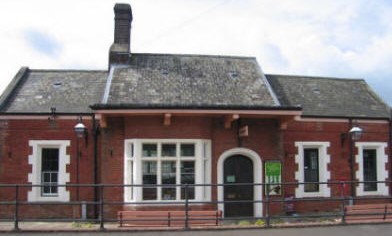
Crediton station built by Berry to a design by I.K.Brunel
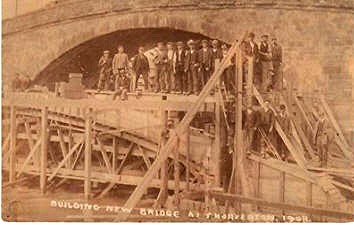
Replacing
Thorverton Bridge in 1908
The contract to maintain several county road bridges continued into the third generation under the care of William Boddy Berry. His son Hubert Berry, who took over the business about 1900, was something of an inventor and innovator. In 1907 he won the contract to replace the 16th century bridge over the Exe at Thorverton. Using reinforced concrete, which was a novelty at the time, the single span structure is believed to be the first of this construction in Devon. It was opened on 1st December 1908, for a final cost of £2392. It was load tested to 66 tons, which caused the middle two arch ribs to deflect 3/32 in. at the centre of the span, and the two outer ribs to deflect 1/16 in. The bridge was strengthened in 1997.

Thorverton Bridge
By 1890 the business became " Builder and General Contractor, Stone and Marble Monumental Mason, Undertaker and Dealer in Building Materials". Hubert took on partner Edwin Vincent in 1923. Finally Hubert retired and the business whilst retaining the name Berry, was run by the Vincent family. The business subsequently changed hands a few times before finally going under in 2008 after more than 200 years.
I am My Own Grandpa
Many many years ago when I was twenty three,I got married to a widow who was pretty as could be.
This widow had a grown-up daughter who had hair of red.
My father fell in love with her, and soon the two were wed.
This made my dad my son-in-law and changed my very life.
My daughter was my mother, for she was my father's wife.
To complicate the matters worse, although it brought me joy,
I soon became the father of a bouncing baby boy.
My little baby then became a brother-in-law to dad
and so became my Uncle, Though it made me very sad.
For if he was my uncle, then that also made him brother
To the widow's grown-up daughter who, of course, was my stepmother.
Father's wife then had a son, who kept them on the run.
And he became my grandson, for he was my daughter's son.
My wife is now my mother's mother and it makes me blue.
Because, although she is my wife, she's my grandmother too.
If my wife is my grandmother, then I am her grandchild.
And every time I think of it, it simply drives me wild.
For now I have become the strangest case you ever saw.
As the husband of my grandmother, I am my own grandpa!
Colebrooke Connibeers - Not Quite Respectable
Robert Connibeer and his wife Elizabeth, née Salter, seem to have been the kind of family that might attract attention in a small rural community, and perhaps at the beginning of the 19th century not for the best of reasons. Robert was from Sandford, and Elizabeth from Dawlish. They tried to settle in Dawlish after their marriage in 1788, but the Dawlish Overseers would not have it, and in the same year Robert and Elizabeth were removed to Robert's home parish of Sandford. But in about 1805 or 1806 the family moved to neighbouring Colebrooke and settled there legally. They had at least twelve children - seven girls and five boys. Two of the girls died in infancy, perhaps three. The remaining four girls seem to have been most active in the parish when they reached adulthood. Between the four of them they produced 9 illegitimate children - Elizabeth (Betty) - 2, Ann - 1, Mary - 3 and Grace - 3. Collectively the four Connibeer girls were responsible for 25% of the base children baptised in Colebrooke parish between 1813 and 1837. There were a series of bastardy orders taken out against a number of different men, including my first cousin 4 times removed, James Fey. The youngest age at which any of the sisters gave birth was Elizabeth whose first son William was born when she was just 15 or 16. According to the bastardy examination " in the month of February last past (1806) she was mett on the road leading to Crediton by a Man whose Name was unknown to her who had Connection with her and he alone is the Father of the said Male Bastard Child, he the said Stranger having had carnal Knowledge of her Body on the Spot once and not since". Betty may, of course, have been protecting the true identity of the father, or the stranger may have forced his attentions on her, though there is no suggestion of that in the bastardy examination.
 Bastardy order for Mary's child
Bastardy order for Mary's child
Even the girls' sister-in-law was of similar character. Sarah Hingston, who married brother Samuel Connibeer, had herself been responsible for two of the other base children born in the parish, to different fathers, before she married Samuel.
James Wright, West of England Iron Works.
In May 1881 the Devon County Show was held in Crediton. Great Great Grandfather Wright took a stand for his West of England Iron Works, and advertised the fact in all the local papers. According to the report in Trewman's Exeter Flying Post, he had one of the largest and most varied collections of implements and ironwork to be found in the show. His exhibits included specimens of ornamental gates "for which he has been honoured with Royal and most distinguished patronage including the Prince of Wales, the Duke of Somerset, Earl Portsmouth, Earl Devon and others."
The list of implements displayed on James's stand is fascinating. Ploughs included "the A.1 Champion, fitted with steel breast plate" and several implements and other general purpose ploughs "of his own invention and manufacture". Evidently the Champion Plough had been very successful , winning ploughing competitions throughout the county, and critical acclaim at the Taunton Show, the Royal Bath and West Show and at agricultural shows throughout Devon. 

Wright's farm implements
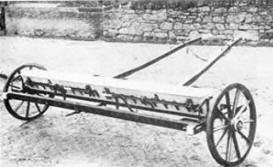
Upstairs Downstairs
There are several hundred records of both our male and female ancestors working as domestic servants, but only eight or nine records of male ancestors working as butlers. Two are featured here. Arthur Heard, a 2nd cousin, was born in 1892 in Wellington, Somerset, where his mother was a housemaid and unmarried. He was brought up by family members. He enlisted in the 1st Bn., Devonshire Regiment in 1915. In 1917, suffering gunshot wounds to his left arm, shoulder, neck and leg he was medically discharged from the army. He married Louisa from Herefordshire in 1920, and by the time of the 1921 census he was employed as butler to the Rt. Hon. Sir George Otto Trevelyan, 2nd Baronet, MP, OM, PC, FBA, a British statesman and author. In a ministerial career stretching almost 30 years, he was twice Secretary of State for Scotland. He was also a writer and historian - author of the novel The Competition Wallah, and the political work, The Life and Letters of Lord Macaulay - his maternal uncle. It is not known how long Arthur was working as a butler. Trevelyan died in 1928. By 1939 Arthur was a munitions worker.


| Sir George Otto Trevelyan, and his estate, where Arthur worked for him, Wallington Hall, Wallington Cambo, Northumberland. |
Like Arthur Heard, Charles Head had served in the
First World War, though he escaped without a wound. He was born in Canterbury
in 1895, and had been in domestic service as a valet. Then he joined up
in 1918, and served in the Tank Corps. He suffered from myopia. In 1918 he
married cousin Jane Hatten, in Sandford. Soon after the pair of them entered
into employment with Horace Annesley Vachell in Lyndhurst, Hampshire.
Charles was butler and his wife Jane was cook. There was also a housemaid and
a kitchen maid in the household.
Vachell had lived in California where he married and was employed in land
dealership. He is said to have introduced the game of polo to Southern
California. He married his business partner's daughter. They had two
children, but sadly he lost his wife shortly after the birth of their second
child. After 17 years Vachell returned to England, and became a
very successful writer. He wrote over 50 volumes of fiction and 22 stage
plays. Many of his works were adapted as motion pictures, radio plays,
and even TV productions in the 1940s and 1950s. One of the film adaptations
was produced by Alfred Hitchcock, though not directed by him. Much of
his writing depicted a comfortably prosperous English way of life.
Charles and Jane went on to work in hospitality,
managing public houses. By 1939 Charles and Jane were running the George
Hotel at 506 Fulham Road, Chelsea. Charles died at Xmas 1939.


Left: Marriage of Charles Head to Jane Hatten.Right Horace Annesley Vachell
The Abandoning of Sarah Hector
Sarah, daughter of pioneer Crediton photographer William Hector,
inherited the creative genes in the family, as she was a music teacher, and
several of her descendants were musicians. Edwin Fey probably met Sarah
through his brother William, who lived next door to her in Crediton. Sarah
married Edwin in 1870 in Bristol. Many of the Crediton and Shobrooke Feys
had moved to Bristol, for as skilled tradesmen they could make good money
in the expanding city. At some point in the early 1870s Edwin went to the
USA looking for work. He appears to have prospered in the Chicago area, and
returned to Bristol in 1876. For a while he was content to remain in
Bristol, building houses in St George, St Andrew's and Bishopston. But it
seems that he was unable to sell the houses for the returns that he was
hoping for. he tried to persuade Sarah to migrate to the USA with her. As she was then expecting their sixth child she was reluctant to make the journey, and could not be persuaded to go with him. Feeling that he had left his family well-provided for, Edwin left his wife and "eloped" with her best friend to the USA. This companion supposedly killed herself.
Sarah struggled financially, having problems accessing some of the funds
that Edwin had left for her. She was obliged to borrow, and to put herself
and two of her sons on the parish, the other children being put out to
nurse with the help of a family friend. Edwin changed his name to
Frank Green, and bigamously married Rose. It is believed that Sarah heard
nothing more of him. Though he was in contact with his sons in 1892,
when as Frank Green he was living in San Bernardino, and Reginald contacted
him to ask for money. Thinking herself to be widowed, in 1911 Sarah married George Bigwood in Bristol. She died in 1939. Edwin died in California in about 1923, having
eventually made a success as a builder. Family stories say that Edwin always had tears in his eyes when he spoke of the family he had abandoned.

Isolation and Death in Winkleigh - a Rural Tragedy
In 1796, a year after Susanna Crossman married militiaman John Heard in Sandford, Charity, a distant Wensley relative, married farmer John Luxton in North Tawton. The Luxtons had been landowners around Winkleigh for generations and could trace their line back to the 14th century. Charity's great grandson Robert John Luxton of West Chapple Farm, Winkleigh, had been raised by his father Laurence on a creed of ruthless self-sufficiency and thrift as the only way to survive the pressures on late 19th century agriculture that had ruined his less prudent and wealthier farming cousins. In Robert John this creed developed into a tyrannical Puritanism and fear of intrusion. He drove off the suitors of his daughter Frances, hoping perhaps she would marry a cousin as so many of the Luxtons had before, keeping the land within the family. Her brother Robbie, the eldest son, inherited his father's suspicion and resistance to change, and in turn destroyed his younger brother Alan's wedding plans. After Robert John's death in 1939, his children Frances, Robbie, and Alan lived on, unmarried, in the remote farm.





Left to right:Laurence Luxton, Robert John and Wilmot Luxton with Frances and Robert, Frances Luxton, Robert Luxton, Alan Luxton
Frances and Alan sought to assert their independence, and to break out from the smothering gloom of brother Robbie's parsimony. The war brought US flyers to an aerodrome on the outskirts of Winkleigh. And for a while Frances and Alan in particular were caught up in the changes accompanying this great upheaval. After the war Alan joined the Young Farmers and hoped to modernise West Chapple's farming methods. But Robbie resisted this, and in many ways West Chapple continued to be farmed much as it had been in the mid nineteenth century. There was limited mechanisation and very little investment in modern machinery. Old almanacs served as textbooks for good husbandry. In fact the farm thrived under this care, but in some respects it was as if the dead hands of their ancestors were always struggling to shut out the twentieth century. Robbie even made the farm less accessible, closing off an entrance. Alan suffered a nervous breakdown and was hospitalised. When he came home he would stay in his bedroom for weeks on end. Frances was more outgoing and friendly in the village, visiting neighbours. But she too became more withdrawn, rarely venturing out except perhaps to visit family graves in Brushford churchyard three miles off, where today a bench commemorates her visits.
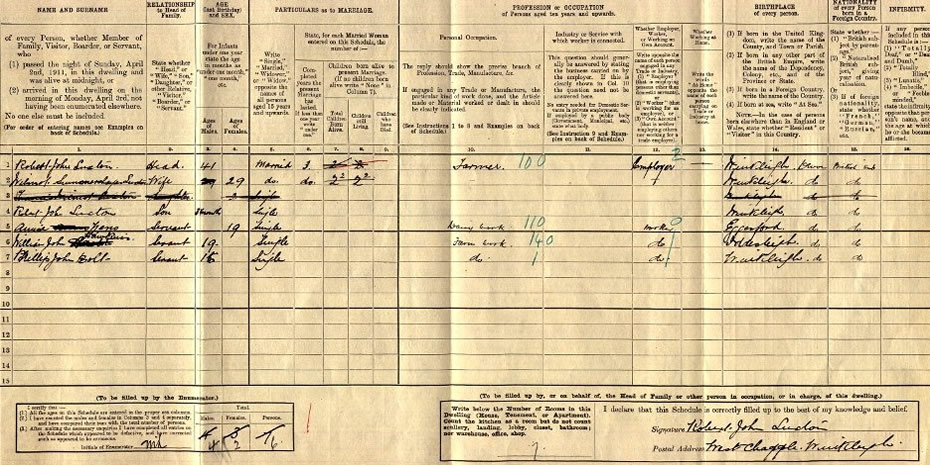
Robert John and Wilmot at West Chapple farm at the 1911 census. Only baby Robbie was with them, as Frances was staying with her aunt and uncle in Somerset.
Gradually the two brothers and the sister became more reclusive, miserly and eccentric, and turned in on each other and the farm. Yet for a while in the 60s and early 70s Frances seemed about to escape, and would embark on long foreign tours with a friend to the Holy Land. But always she was drawn back into the closed world of West Chapple. As old age encroached on their isolated existence it became clear that with the youngest, Alan, unfit to work the farm, their enclosed lifestyle could not be sustained. In 1975 it seemed certain that they would sell the farm and retire to a modern bungalow in Crediton perhaps. There was talk that they had bought a bungalow, that a deal had been struck for West Chapple: but in fact there had been rows, anxiety and uncertainty. "We were born on the farm and we should die here". A worry that Frances was heard to utter again and again. This may have seemed sinister to city-dwelling outsiders, but a farming colleague of mine, much more worldly than the Luxtons, told me that the only move he had made in his life was to a different bedroom when he got married, and that it was a soul-tearing wrench he still felt whenever he had to sell any land - land that was his birthright.
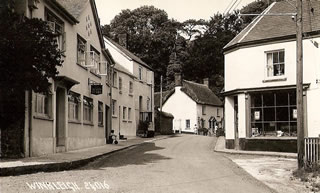
Left to right: Frances's grave in Brushford churchyard, alongside the tomb of John Luxton; Winkleigh Village,
and the stone covering Alan and Robbie's ashes in Winkleigh churchyard where they are buried with their parents and grandparents.
Alan in particular seems to have objected aggressively to the sale, arguing with both his brother and sister. They had sold their cattle, but were still not absolutely committed to the sale of the farm. But it seems that Robbie was convinced it must go forward. On 23rd September 1975 a grocer's roundsman calling at the farm saw a white scarecrow lying next to the barn. On closer inspection he found that it was Alan Luxton in pyjamas and boots, his brains blown out. He summoned police, who cautiously searched the farm, as no gun had been found, and the gunman might still be lurking in the outbuildings. The house was deserted, but after some time the bodies of Frances and Robbie were found in the garden, both too with their brains blown out. Frances was on all fours, her knees drawn up as if in prayer. An old shotgun was beside Robbie. The inquest found that Alan had killed himself first, Robbie had then killed Frances and committed suicide. Victims of their past and of their own dark and claustrophobic lives. Frances is buried in Brushford churchyard. Alan and Robbie were cremated, and their ashes interred in their parents' grave in Winkleigh churchyard. John Cornwell has told the story of the Luxtons and West Chapple in Earth to Earth, published in 1982, and now apparently out of print. Genealogists should note that some of the Luxton family history there is inaccurate, and allegedly so too are some of his darker assertions about the family.
The pedigree of William Thomas Heard can be followed back to Grace Sharland and through her brother Francis Sharland b.1837, to Grace Wensley, and thus back to Laurence's g-grandparents, John Wensley and Charity Reed. Frances is buried next to John Wensley in Brushford.Civic Duty |
Over the years several of our family fulfilled their civic duty through elected office, to councils, to parliament or to other bodies that managed the affairs of their communities. The earliest were the three generations of Hookers. John Vowell Hooker (d. 1493) was Mayor of Exeter in 1490 and a Member of Parliament five times during the reigns of Edward IV, Richard III, and Henry VII. His son Robert was Mayor of Exeter from 1529 - 1530. His grandson John Hooker was the first Chamberlain of Exeter, was the city's coroner and the MP for the city in 1568 and 1570-71. He also sat as a Member of the Irish Parliament. The Sadleir family provided the great statesman Sir Ralph Sadleir in the 16th century. John Sadler was an Alderman and then High Bailiff of Stratford on Avon in 1570-71, his brother Roger was an Alderman, and was High Bailiff in 1572-3, and his son John was made Alderman in 1598, High Bailiff the following year and again in 1612 -1613.
Thomas Sadleir was made Governor of Galway in 1655, he was MP for Tipperary
from 1661-1666, and was High Sheriff for Tipperary in 1666. In the 19th century swindling brothers John and James Sadleir were both MPs. John for Carlow, and later Sligo, and James for Tipperary. John was made a junior Treasury Minister before his fall from grace. James was one of the few MPs to have been expelled from the Houses of Parliament. Francis Hext (1736-1803) was Mayor of Bodmin in 1762 and 1768. His son Francis John Hext was Mayor of Bodmin in 1773, 1779, 1786 and 1789. Nicholas Pitts (1799-1870) was Chairman of the Board of Guardians, and member of the Parish Vestry for Kingsbridge, Devon. He had been one of the Guardians for Chivelstone before moving to Kingsbridge. Lewis Wright(1850-1928) had been a member of the Parish Vestry and was elected to the first Sandford Parish Council. He remained a member for many years. He was also on the Board of Sandford Charity Trustees. William Boddy Berry was Chairman of Crediton Urban District Council in 1895, William
Henry Adams was Chairman from 1919 to 1928 and Arthur Bicknell was Chairman in 1932. Arthur Madge Bennett (1905-1980) was described as an Amalgamated Engineering Union stalwart. He worked for the GWR. After WWII he was elected Labour Councillor in Swindon Borough Council, was Mayor of Swindon, and was made an Aldernman. After a working life striving to help others, William Williams stood for Bristol City Council, and he was elected to represent Eastville Ward. He served on the Council until 1983, and also served on the National Executive of the Labour Party and on the Council Public Works Committee. After losing the Council election in 1983, he was made an honorary Alderman of the City of Bristol. |
|
|
Our Middle Classes, Family Networks, Politics and Funny Handshakes
The 19th century saw an expansion of the middle-class, a term that referred to a social category of such a diverse range of people that there could be no satisfactory single definition of it. This diversity encompassed everything from the great industrialists and manufacturing entrepreneurs, professionals, politicians and public servants to shopkeepers, merchants, clerks, and tradesmen. Class was not determined by wealth, for it was not unusual for skilled working class men to earn more than many who would be considered middle-class. In reality there was a middle-class and a lower middle-class. And in Crediton, a small Devonshire market town, the make-up of both differed from the middle-classes of the Metropolis, or the great manufacturing and industrial conurbations. So how to define it? Historian E.P.Thompson suggested a criterion that might define our middle- and lower middle-classes wherever they were living. "Class happens when some men, as a result of common experience (inherited or shared) feel and articulate the identity of their interests as between themselves, and as against other men whose interests are different from theirs." - it was how people regarded themselves and were in turn regarded. The study of our families in 19th century Crediton suggests that a strong middle class emerged, as the tradesmen of the town began to regard themselves as distinctly separate from other social groups. They identified joint interests, and realised that their economic power and status set them apart from both the local squirearchy and the labouring classes in a more cohesive way than before. They established social networks with merchant neighbours who shared their interests, often cementing the relationships through marriage. Throughout the 19th century in Crediton it was as if a local mafia sprang up, with shopkeepers, tradesmen, innkeepers and similar socialising with each other, and marrying into each other's families. It seemed that occupying commercial premises on the town's High Street was an entrée into a marriage club! Master tailor Bicknell married mason's daughter Prawl, currier Adams married baker's daughter Vicary, plumber Berry married publican's daughter Milton, jeweller and watchmaker Bellringer married builder's daughter Berry, builder Berry married grocer's daughter Boddy, photographer's son Cornish married auctioneer's daughter Helmore...These were some of the members of our extended family in Crediton's middle-class. These people all had businesses that in the main employed others. But our families did more than reinforce their collective identity through marriages.
Although the magistracy seems to have been the preserve of the traditional landowning aristocracy of Mid-Devon, our burgeoning middle class in Crediton sought to exercise some influence through participation in local politics.
We find in the minutes of the Crediton Parish Vestry between the 1850s and 1880s that our family is represented by the participation of builders William and John Berry and William Boddy Berry, photographer William Hector, watchmaker William Hector, John Hector, plumber James Gover, tailor Charles Bicknell, overseer Thomas Pollard, tanner William Adams, and machinist Lewis Wright.
With the urbanisation of local government, our middle class began to consolidate its influence, and these same family members were elected to the board of Improvement Commissioners and Urban Sanitary Authority. When the new Urban District Council was established our cousins William Adams and William Boddy Berry were elected, the latter being appointed chairman. The 19th century saw a tremendous growth in friendly societies. They were to evolve into different guises over the years, but for the purposes of our socially mobile ancestors in Crediton, membership of such a society confirmed their collective identity: an oath, secret signs and knowledge, exclusive regalia marking office and achievement, members’ contributions and a sense of exclusiveness based on a line drawn between ‘insiders’ and ‘outsiders’ - thus did our middle class receive their recognition and respectability. There have been several friendly societies in Crediton over the years - the Ancient Order of Foresters, the Royal Antediluvian Order of Buffalos, the Loyal Order of Moose, and the Freemasons. It was the latter that perhaps offered the greatest kudos to our aspirant family- for the last quarter of the century the Prince of Wales was the Grand Master of the Freemasons! It is no surprise therefore that examination of the membership of the Crediton Unity Lodge No 1332 of the Freemasons from 1870 to 1920 reveals that familiar family names appear. Worshipful Masters of the Lodge included painter William Thomas, builder William Boddy Berry,
auctioneer Frederick Helmore and jeweller William Hector (At his death in
1925 William was the oldest Past Master, and a Past Provincial Grand
Organist of the Province of Devon). Other family members "on the square" included lawyer Thomas Hector, tanner Percy Bruce Adams, photographer Henry Cornish. William Boddy Berry was both the architect and the builder of the brand new Masonic Hall in Union Road in 1888, the year in which he was Worshipful Master. It is clear from the names of the Crediton Freemasons that our family members and other tradesmen did not simply join the ancient order. Fathers in the 1880s were followed by their sons in the 1900s and 1910s. They, their friends and in-laws were the local Freemasons. They had consolidated their middle class status through tacit engineering of social networks and local structures. By the middle of the 20th century, with the disappearance of the aristocracy, many of these families were regarded as the "gentry" of Crediton.
Some Tragic Accidents in the Family
Captain George Blackler
was lost at sea from the SS Archimedes, 1923, aged 53
Alfred Harris, working on Black's Bridge for the CNR railway, accidently slipped and fell to his death. His body was found when it surfaced the following spring.
Ernest Fey was knocked down and killed by an army truck in 1945, at Shoreham, Sussex, aged 77
Mary Dicker was knocked down and killed by a Harrods electric van in the blackout in 1939, aged 70
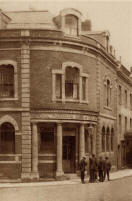
William Berry, Builder, fell from a ladder while building this bank in Crediton; he never fully recovered, dying in 1874, aged 67
Walter Faithful Crabbe
operated a ferry on the Clarence River at First Falls, New South Wales. He drowned in an accident on the river in 1849, aged 34
John Perrin Huxtable
died of injuries received in a railway accident in Australia in 1893. A railway guard, he fell, jamming his leg between the wheel and the lubricating box of a coal truck. He died of his injuries in Prince Alfred Hospital, Camperdown, Sydney.
Ernest Heard, aged 10, drowned in a quarry pit whilst fetching water at Morchard Bishop, in 1894,
Charles Procter, died as a result of an accident whilst working for his father's haulage firm, in 1936, aged 38
Gerald Manning Goding, who worked for the railway in Queensland, died aged 59, in 1936, following a collision between two rail trolleys when his head struck a rail sleeper.
Henry Goding was killed by a fall of rock
in a cave at the Band of Hope Mine, during the Australian goldrush in 1898, aged 25.
Samuel Haydon
survived severe injuries from being crushed between his cart and a wall in November 1903.
Nester Saffin,
71, and her son-in-law Donald Nicholson, 40,were killed as a result of a motor accident at Willaura, Victoria, Australia in 1984
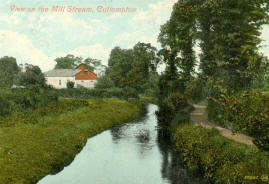
The mill stream at Cullompton
Solomon Hughes, Trinity Pilot, died on his schooner Margaret, caught up in an anchor whilst trying to disentangle it, in 1878, aged 45
William Drew Degeer, 22 and his wife
Linda née Mueller,21, were tragically both killed in a traffic accident the day after their wedding in April 1956, in British Columbia, Canada.
John Ashplant was killed by a train whilst walking home to Crediton on the railway line, aged 55 in 1901. He was probably the worse for drink.
In a shocking tragedy Heather Habner, née Saffin, 38, and her daughters Belinda, 15, and Kylie, 7, were killed in a road traffic accident in South Australia, on 17 July 1991
On 28th March 1891 great great uncle
James Wright suffered the accident described above, (from Trewman's Exeter Flying Post of April 4 1891)
His sister-in-law noted in her diary " James Wright - first accident took place at Sir John Shelley's sawmills, Shobrooke Park". She had noted it some years after the event, perhaps on the occasion of a second accident of some description. But in fact accident-prone James had injured his eye in an earlier accident in 1866.
Despite the apparently horrific nature of this injury, James somehow survived. The census was held a week after the accident, and James was with his wife in Crediton, his mother also there, presumably helping to care for him.
In fact James outlived his first wife, having moved to Yorkshire with her to live and work. He married again in 1903. He died in 1909. Strangely there was no mention of this accident in subsequent Wright generations, perhaps because he died before the birth of any nephews and nieces.
Arthur Ashplant - International Brigader
Arthur served with the Royal Field Artillery in the First War and was with the 37th Brigade in Egypt. He was demobbed in June 1919, and was awarded the War Medal and the Victory Medal. In 1921 he was working for the Midland Railway in Derby, labouring in their carriage and wagon works. In 1928 he decided to try a new start. He emigrated to Canada, under the Landed Immigrant Scheme, intending to farm. He sailed to Quebec on the SS Doric on 27 July 1928, describing himself as a colliery worker. He continued west to take up land granted by the Canadian Government at Calgary, Alberta. But the Great Depression was to strike everybody in the 1930s, and many Canadian farmers suffered. There was much poverty and homelessness.
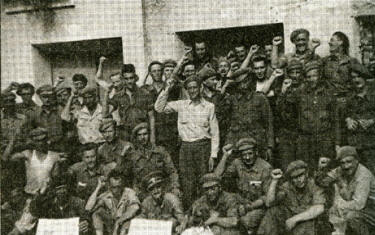
Mac-Pap Battalion of the XVth International Brigade

Battles fought by the Canadians and the
Mac-Pap Bn of the XVth International Brigade.

Mac-Pap Brigaders on the Aragon Front in 1937
In contrast the Royal Canadian Mounted Police objected to the return of the Canadian volunteers as communists and troublemakers, and they were delayed in France until the end of January 1939, when they were finally allowed passage home. Arthur, on the Duchess of Bedford, full of other Canadian volunteers, sailed back to Halifax, Nova Scotia, on 3rd February 1939. He returned to Calgary, where he lived and worked for the rest of his life with his wife Jean.
On 28 March 1939 Madrid surrendered to Franco: the Republican Army unconditionally surrendered on 1st April. Almost half of the 1600 Canadians who had gone to Spain never returned.
Listen to Pete Seeger singing a song of the XV International Brigade.
Thanks to Nigel Ashplant for telling me of Arthur's life.
From Exeter & Plymouth Gazette, 1 January 1909 (our Samuel)
The Beast in the Family
A member of our Labbett family, Mark Labbett is well known as The Beast - one of the Chasers on the UK afternoon quiz show "The Chase". Mark is also in the U.S. version of the show. 
Going Postal
For a large number of family members, employment in
postal services seems to have been an attractive option. Perhaps
that reflects the growing importance of the Post Office in the daily
lives of our ancestors as it increased its services. Charles I made the postal
service available to the public in 1635, with recipients paying
the cost of postage. By 1793 uniformed post men had appeared on
the streets for the first time, and in 1830 the first mail train
from Liverpool to Manchester made its first deliveries. So by the
time of the first adhesive postage stamp and the Uniform Penny
Post established in 1840, there was already great demand for the
service, and most villages had their own Post Office.
John Pickett was a tailor and shopkeeper, and on 24 February 1844 he was appointed Post Master for Sandford.
By 1891 daughter Eliza had
taken over. Thomas Heath was Post Master at Totnes, then Tiverton
at the end of the C19th and the beginning of the C20th. In 1901
Eliza Heard, née
Wright was Sub-Postmistress at the grocery shop at 6 The Green,
Crediton. On 18 June 1855 Miss Sidney Ralling was appointed Post
Mistress at Copford, Essex, where she ran the grocery store on
Copford Green. The Post Office provided opportunities for women.
When she died in 1902 Sidney left effects valued at £1380.
Reuben Heard,
Luke Fey,
William Labbett and
William Crispin worked
as post office messenger boys. Luke Fey went on to serve as a
London postman from 1894. He was killed on the Western Front in
1916. His second cousin, Gertrude Fey, married into a dynasty of
postal workers in Bristol. Her father-in-law, Edward Bartley was a
letter stamper with the GPO (franker?), her husband Frank Bartley
was a letter sorter and then a postman, their son Percy Bartley was a GPO engineer. Other
postmen include George Pett in Cheriton Bishop,
Edwin Davis in Teignmouth, father
Archibald Horrill in Isleworth
and son Archibald Horrill in Richmond, then Dagenham,
Ivor Wright in Exeter,
Eber Greenwood in Holsworthy,
Harold Parker in
Burton-On-Trent, George Adams in Southwick,
James Mitchell and
Daniel Sharland in Cruwys Morchard.
Frank Conbeer was an auxiliary wartime postman in Crediton in
WWII. It was not unusual for the postmen to work at other jobs
simultaneously. James Mitchell was also a shoemaker. He
served as a rural postman for 33 years before his retirement. Daniel
Sharland was receiving a pension after 21 years as a Royal Marine.
He was formally appointed as a rural postman in January 1902. Postwomen included
Sarah Jane
Heard née Lynes, in Warwickshire and
Eliza Crook in Cruwys
Morchard. Leonard
Wills was a Post Office engineer, and
Henry Stevens
a telegraphist in
Westminster. Henry was promoted to Assistant Superintendent
(Tels) before he retired.
Family members
working as counter clerks or assistants in Post Offices have
included Miriam Carpenter in
Bournemouth, Charles Ralling
in Colchester, Alan Wright in
Crediton, and in 2019 there was still a Heard working in the Post
Office in Crediton.
Our overseas cousins include at least one postal worker: a Sharland cousin, Melvin Battige, who was a rural letter carrier in Dansville, Michigan, USA.
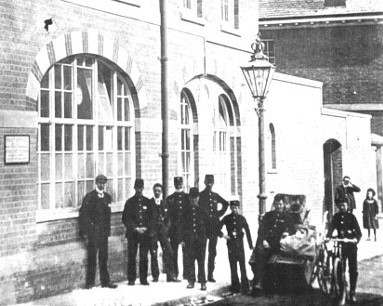
Crediton Post Office and Postmen

Victorian Middle Class family at tea

W.B.Berry's design for the Masonic Hall, Crediton

Members of Unity Lodge No.1332, the Crediton Freemasons, outside the Masonic Hall, Union Road, Crediton, awaiting the triumphal return of General Sir Redvers Buller on 10th November 1900. The banner reads, "Praise the Great Architect of the universe for Sir Redvers' safe return". Cousin William Boddy Berry is third from left.
Brother Ralling
On the subject of Freemasons, Thomas Ralling, brother of architect Octavius, was described in Masonic literature as "one of the best known masons in England".
He was initiated into Freemasonry on the 19th October 1869, and duly passed and raised in the November and December following, in Angel Lodge No. 51, the oldest lodge in the Province of Essex. There began a Masonic career resulting in Masonic High Office for him. In June 1871 he was appointed Secretary of the Lodge, and he was Master in 1877, in which year he was also appointed Provincial Grand Secretary of Essex, which office he held until his death in 1924.
In 1883 as Grand Junior Deacon of England he assisted at the advancement of the Prince of Wales as a Mark Mason.Ten years later, at the great meeting held at the Albert Hall on 13th June 1897 to celebrate Queen Victoria’s Diamond Jubilee, he was appointed Assistant Grand Director of Ceremonies, and he was promoted to Past Grand Deacon in Grand Lodge in September 1916 where he was presented by the Provincial Grand Master Colonel Lockwood with the collar that he himself had worn when he had held a similar rank. He was, in 1894, the first Founder and first Master of Thomas Ralling Lodge, and he was Master of the Essex Masters Lodge No. 3256, founded at Colchester in 1907. At the time of his death he was the Master of the Fratres Calami Lodge No. 3791 – membership of which was confined to Secretaries of Lodges! In Royal Arch Masonry, he was exalted in Patriotic Chapter, No. 51 on 11th May 1871, appointed Scribe E, in 1873 and installed as MEZ in 1883.
On the formation of the Essex Provincial Grand Chapter in 1873 he was appointed its Provincial Scribe E and in 1887 he was appointed Grand Sword Bearer of England. He was a founder, in 1907, of Thomas Railing Chapter, and was its first MEZ. Outside of Craft Masonry, in the Mark degree he was advanced in the Constantine Lodge No. 145 in 1872, became Secretary in 1873, and occupied the Chair for two years in 1880 and 1881. He was appointed Grand Overseer of the Mark Province of East Anglia on its constitution in 1883, and Grand Junior Deacon in the Grand Lodge of Mark Masons a month later. In 1899 on the formation of a separate Essex Mark Province he became Provincial Grand Mark Secretary, which appointment he also held until his death. In 1919 he was promoted to Past Grand Junior Overseer of England. He was also a Royal Ark Mariner and first WCN of George Graveley Lodge No. 461 (and its Scribe!). He held numerous other senior offices as a Knight Templar and in Rosicrucian Chapters. He initiated his seven brothers including Octavius into Freemasonry, and also his son William.
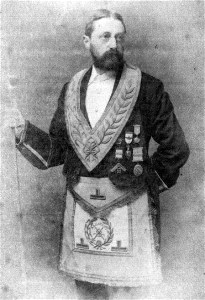
Bro. Ralling in regalia
- Membership of these friendly societies and masonic-type orders was not confined to family members in the U.K. We learn from his funeral notices in 1936 that cousin Harry Pickett had been a Past Arch Brother of the Star of Epping Lodge no 511 of the United Ancient Order of Druids, in Epping, Sydney, NSW, Australia.
- And professor of music Joseph Pollard was a member of
Golden Lodge, of the Freemasons in Bendigo, Victoria, Australia from 1859. It is not
known if he remained a member when he returned to England to live in
Ramsgate ten years later.
- Another Freemason Professor of Music was Chastey Hector,
intiated into Hove Ecclesia Lodge in 1919. He was organist at Brighton
parish church.
Fatal Fire at Shobrooke
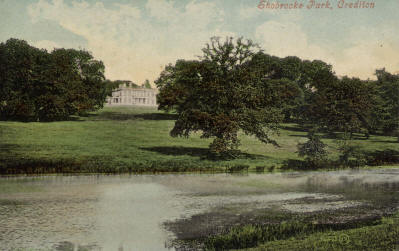
Shobrooke House, some two miles from Crediton, has featured in the family history in several ways. The manor house and park was known as Little Fulford for most of its history, and was in the hands of the Tuckfield family and their descendants. In the late 18th and early 19th century Day Books of our builder John Prawl, and then his protégé , John Berry, Fulford appears as a source of much work, and almost daily one or more of the builders' craftsmen are working there. With its pleasant parkland and ornamental pond, it became a favourite place for a picnic, particularly when courting. At least one Heard made a photographic record of trips to the park. The Shelley family, cousins to the Tuckfields, took over the estate in 1880. In the mid nineteenth century the name had been changed from Fulford to Shobrooke Park. During the Second World War, St Peter's Preparatory School was evacuated from Broadstairs to Shobrooke House. Former pupils had included the Duke of Kent and the Duke of Gloucester. Amongst the pupils evacuated then was Peter de la Billiere who was to become General Sir Peter, Commander of British Forces in the Gulf War of 1991.
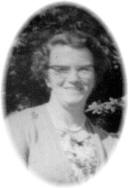
Rachel Wright

Read a contemporary newspaper account of the fire
Perhaps it's easy for us to forget these days how great a hazard fire was for our ancestors, in their thatched cottages, with open grates and scant regard for fire precautions. I can remember in my childhood decorating Xmas trees with real miniature candles in clip-on holders! My grandparents lost all their possessions when their cottage at Redhill, Morchard Bishop (left) was destroyed by fire in December 1939. Kate Pitts, her daughter Sadie and a blind lodger, Miss Willmet, were at home, Nicholas Pitts and son Laurie having gone to work. About 8.45 am a spark from the chimney ignited the thatched roof. In no time at all the cottage was ablaze, and the fire quickly spread through the entire row of four cottages.

My grandmother and mother at the door of the Morchard cottage
A passer-by raised the alarm, and a retired policeman who lived nearby helped to rescue some of the elderly residents who were still in bed. The cottages stood on the brow of a hill, and the December wind fanned the flames. There was no time to retrieve much in the way of furniture or possessions. When the fire brigade arrived 45 minutes later the blazing roof had fallen in; nothing could be done to save the buildings. 13 people were left homeless. No trace of the cottages remains today. They have been replaced by smart bungalows.
Read a contemporary newspaper account of the fire.![]()
Royal Meal
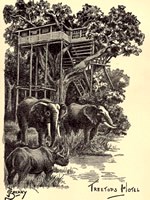
Treetops Hotel, Kenya, where the Princess
was staying when the King died.
Thanks to his daughter Val for the information.
The Consultant Surgeon and the Tigers

One of the patients in theatre
Thanks to Sue Pearkes, for the story and picturesWhen our cousin circus vet Fernley Slee contacted Ian Payne FRCS, consultant opthalmic surgeon at the Plymouth Royal Eye Infirmary, sometime in the mid-50s, Mr. Payne found that Fernley was to introduce him to the most unusual patients of his career. Two tiger cubs, Lily and Rajah, in the possession of Chipperfield’s Circus, were suffering from congenital cataracts and Fernley Slee wanted Ian Payne to perform surgery to extract them.
Ian Payne took his wife and young daughter to meet the patients at Fernley's Plymouth house, where the tigers were wandering freely around Fernley's sitting room. Mrs Payne put her white leather handbag on the floor and one of the tigers bit the corner of it, and for years afterwards people would look askance at these teeth marks, and she would say airily, “Oh, it was bitten by a tiger…”
Thanks to Mr. Payne's skills, the tigers recovered successfully from the operation.
Lily and Rajah
Fire Disaster for Grace Heard
At about 10.00pm on Monday 19 January 1891, Vicarage servants observed flames rising from the thatch of Frank Packer's house, at the head of Fanny's Lane, above Chanter's Court , facing Sandford parish church . The alarm was raised in the village, and in no time locals were on the scene, rousing the inhabitants of the Courts there, and helping to rescue the meagre goods and furniture of the inhabitants of the houses. Some ran up to the seat of the fire beneath the burning roof, but it was clear that the flames were rapidly widening and beyond their efforts. Some brought ladders and began to strip off thatch from the roofs to create firebreaks. Sandford fire brigade was soon on the scene, whilst Lewis Snow rode to Crediton to raise the alarm there for the town brigade. The engine arrived from Crediton at about 11.00pm.Unfortunately the fire brigades were unable to access a water supply. There was some criticism later that if the two brigades had only cooperated and made combined use of their pumps and other resources, then they would have been able to tackle the blaze sooner. Unfortunately because they did not, there was a delay of over an hour before thay managed to connect to one well and an improvised water tank at the Vicarage stables. By then the Packer house was fiercely blazing , and the fire was spread to the other buildings in the Court. The ancient courts at the head of Fanny's Lane were doomed. Cob-built, with thatched roofs they were some 200 years old, and undivided in their roof space. The progress of the fire could not be halted until it had reached the rear of the Square, where there were one or two slate-roofed houses; between these and the burning dwellings, the roofs of the other houses were cut away. This slowed the spread of the fire, but it was not brought under control until 3.00 am of the following morning. By then 19 homes had been destroyed. The Sandford fire engine remained at the scene until daylight, and returned on the Tuesday afternoon to dampen down still smouldering timber and thatch.
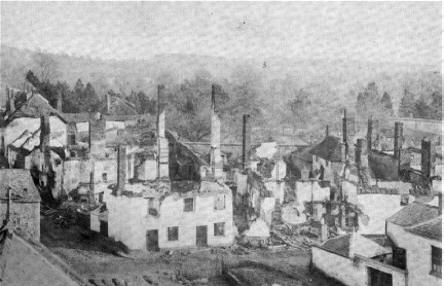
Aftermath of the fire
|
The Vicar, Rev. G. Llewellin had worked tirelessly to help throughout the fire, being one of the first on the scene, and the last to leave. Through his assistance seven of the elderly occupants from the houses were taken to the Vicarage where they remained until alternative accommodation could be found. The furniture and possessions from the houses were hurriedly removed to the churchyard and nearby allotments, much of it being damaged due to its speedy removal.
Nineteen houses were destroyed completely. Some were unoccupied but it meant still that sixteen people were left homeless, including great-great-great aunt Grace Heard and second cousin Elizabeth Jackman . Many of the victims of the fire were already poor, and most lost what little they had then, damaged during its removal, if not burned. The Vicar called a meeting of the parish to collect subscriptions on behalf of the poorer sufferers, to replace those essentials they had lost. With help from villagers, including Walter Wright and William Wright, a house-to house collection raised £58 2s 9d, and gifts of clothing and food were also received. Widowed Grace Heard had been on parish relief for many years. She died in October 1893, aged 57.
Read a contemporary newspaper account of the fire


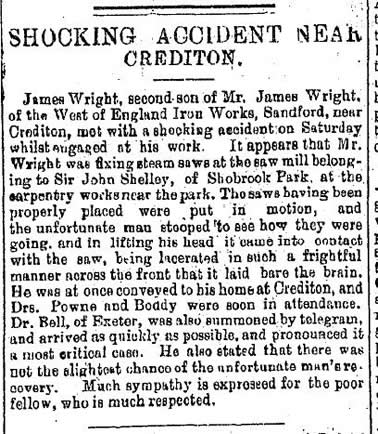








.jpg)


